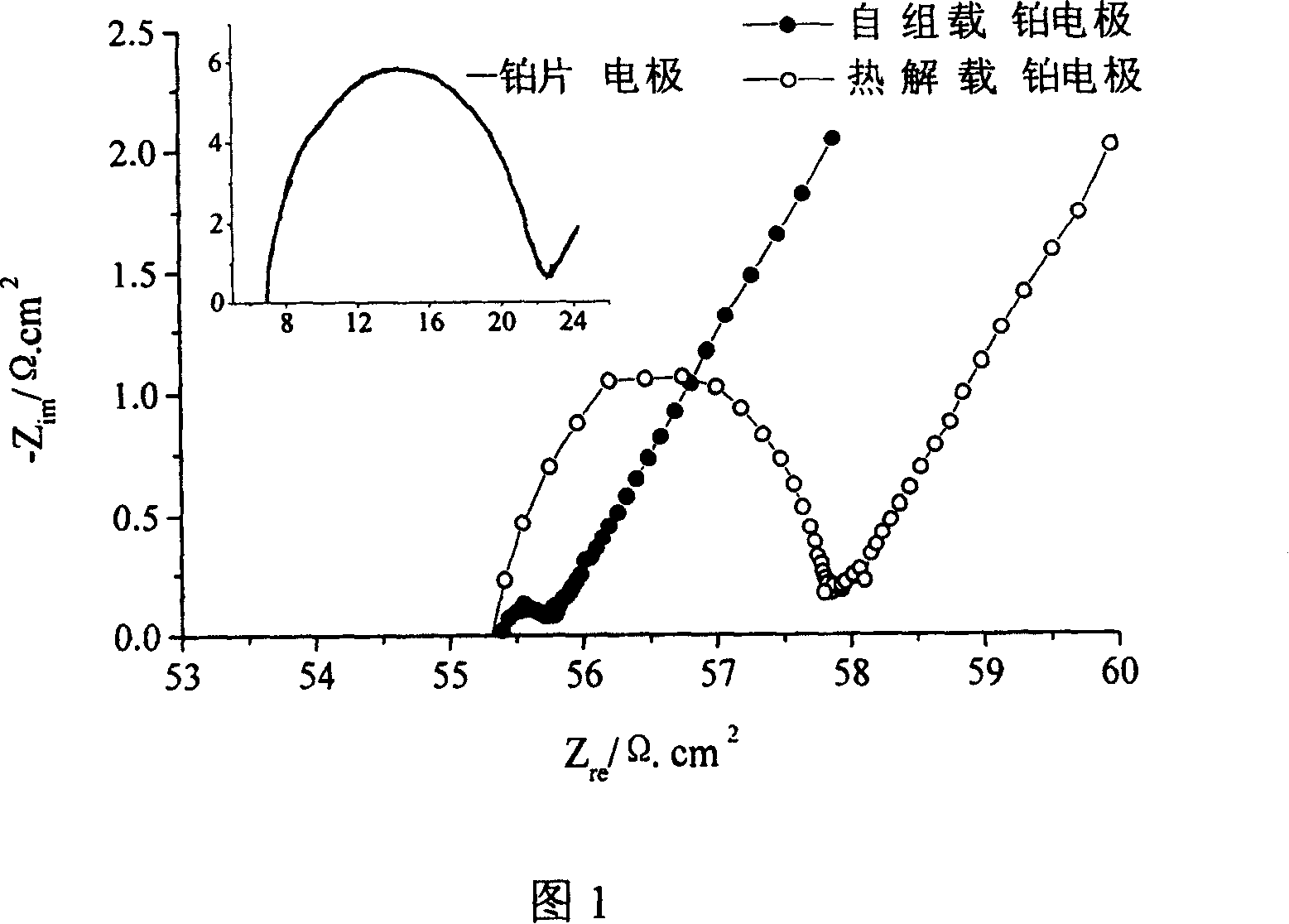Method for preparing Nano platinum carried catalysis electrode in Nano crystal sensitized solar battery
A technology of solar cells and nano-platinum, applied in battery electrodes, capacitor electrodes, photosensitive equipment, etc., can solve the problems of high platinum loading, unfavorable battery practicality, and restrictions on the amplification and preparation of platinum-loading electrodes, and achieve the effect of reducing production costs
- Summary
- Abstract
- Description
- Claims
- Application Information
AI Technical Summary
Problems solved by technology
Method used
Image
Examples
Embodiment 1
[0026] Add 4ml of sodium acrylate aqueous solution with a concentration of 1.0mol / L to 250ml with a concentration of 8.23×10 -4 K in mol / L 2 PtCl 6 50ml of ethanol was added to 40ml of the above solution. After bubbling nitrogen for 15 min, heat in an autoclave at 100 °C for 12 h to make PtCl 6 2- Reduction, to obtain dark brown acrylate-protected nano-platinum colloid solution.
[0027] Preparation is the dodecylmercaptan of solvent with toluene: stearic acid=5: 1 blend solution, wherein the concentration of stearic acid is 5.0 * 10 -3 mol / L. On the L-B film instrument (JC-1 type), the monomolecular film of the blend solution is transferred to the FTO conductive glass (SnO doped with F) with a surface pressure of 30mN / m and a lifting speed of 6mm / min. 2 , Sheet resistance is 20 ~ 30Ω / □) on the surface. The conductive substrate after hanging the film was immersed in the nano-platinum hydrosol for self-assembly, and the self-assembly time was 4 days. After the electrode...
Embodiment 2
[0036] By replacing the alkyl mercaptan in Example 1 with hexadecyl mercaptan and the ratio of stearic acid to 7:1, a nanometer-loaded platinum catalytic electrode with similar performance can be prepared.
Embodiment 3
[0038] The preparation of nano-platinum colloid is the same as in Example 1.
[0039] Prepare 50ml, the xylene solution of 10% (volume ratio) silane coupling agent, conduction glass is immersed in the above-mentioned solution, under N 2 Under the protection of , reflux at 100-150□ for 12 hours. The electrodes after silanization modification were in N 2 Washed with xylene and methanol in turn under the protection of the protection, and then immersed in the prepared nano-platinum colloid solution for self-assembly, the self-assembly time is 1 to 4 days. After the electrode was taken out, it was rinsed with twice distilled water to remove the physically adsorbed nano-platinum particles on the surface of the electrode, dried in air at room temperature, and then placed in a muffle furnace for sintering at 380°C for 15 minutes. The charge transfer resistance R of the prepared platinum-loaded catalytic electrode ct 0.6Ω.cm 2 (using the same test conditions as in Example 1), the c...
PUM
| Property | Measurement | Unit |
|---|---|---|
| particle diameter | aaaaa | aaaaa |
Abstract
Description
Claims
Application Information
 Login to View More
Login to View More - R&D
- Intellectual Property
- Life Sciences
- Materials
- Tech Scout
- Unparalleled Data Quality
- Higher Quality Content
- 60% Fewer Hallucinations
Browse by: Latest US Patents, China's latest patents, Technical Efficacy Thesaurus, Application Domain, Technology Topic, Popular Technical Reports.
© 2025 PatSnap. All rights reserved.Legal|Privacy policy|Modern Slavery Act Transparency Statement|Sitemap|About US| Contact US: help@patsnap.com

